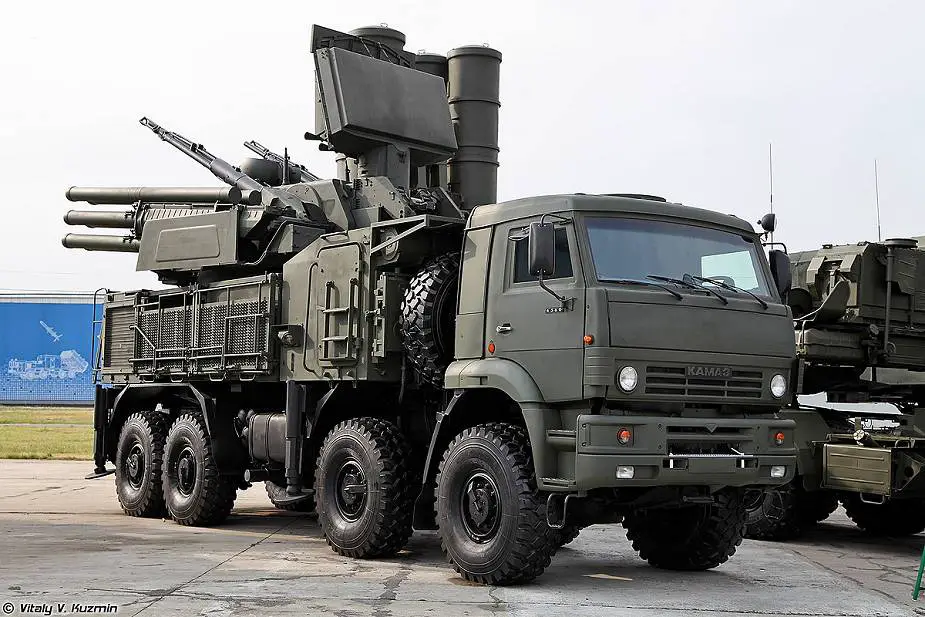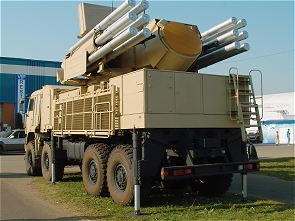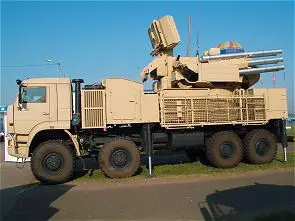- Army
- Air Defense Systems
- Anti-tank systems and vehicles
- Armored Vehicles
- Armoured personnel carriers
- Artillery Vehicles and Weapons
- Command Post
- Communication Vehicles and Systems
- Electronic Warfare
- Engineer | Maintenance Vehicles
- Infantry Fighting Vehicles
- Main Battle Tanks
- Missiles
- Tactical and Logistic Vehicles
- Radars
- Unmanned Systems
- Weapons
- Navy
- Air
Pantsir-S1 SA-22 Greyhound
Pantsir-S1 / Pantsyr-S1 / SA-22 Greyhound
Medium-range mobile air defense cannons/missiles system - Russia

Description
The Pantsir-S1 (SA-22 Greyhound NATO code name) is an air defense missile-gun system designed to protect vital small-size and big military areas, industrial targets and land forces units and reinforced the air defense units responsible for the protection of troops and military installations against precision-guided air attack from low and extremely low altitudes. The mobile version of the Pantsir-S1 system includes a combat vehicle ( up to six vehicles in a battery), surface-to-air guided missiles, 30 mm rounds, a transporter-loader vehicle (one per two combat vehicles), maintenance and training facilities. The Pantsir-S1 is designed by the KBP Instrument Design Bureau of Tula, Russia, and is manufactured by the Ulyanovsk Mechanical Plant, Ulyanovsk, Russia. It has the reporting code name NATO, SA-22 Greyhound. The Pantsir-S1 was unveiled for the first time to the public during the MAKS Air Show in Zhukosvsky near Moscow in 1995. In May 2000, the United Arab Emirates ordered 50 96K6 Pantsir-S1 systems, mounted on MAN SX 45 8×8 wheeled vehicles. The order was worth $734m. The first batch was delivered in November 2004. However, a new radar was requested by the UAE and the first deliveries of the completed system took place in 2007. Syria has placed an order for 50 Pantsir-S1 systems. Deliveries began in June 2008. Jordan has also placed an order for an undisclosed number of systems. The first 10 Pantsir S1 (SA-22 Greyhound) antiaircraft surface-to-air missile systems entered service with the Russian Air Force the 18 March 2010. On January 18, 2020, it was announced the purchase of six Pantsir-S1 by Serbia. In February 2020, Serbia has taken delivery of the first batch of Pantsir-S1.
Pantsir-S1 variants:
- The Pantsir-S1 missile system can be mounted on different truck chassis.
- Pantsir S-2: The new missile will increase the system’s range of fire from 20 to 30 kilometers.
Technical Data
| Armament |
|
The armament of Pantsir-S1 consists of twelve 57E6 surface-to-air guided missiles and two 2A38M30-millimetre automatic guns developed from the two-barreled 30mm GSh-30 gun. It is provided with a multi-range radar capable of detecting aerial targets with an effective surface of dispersion of up to 2-3 square meters at a distance of more than 30 kilometers and tracking them down from a distance of over 24 kilometers. With its missiles, the Pantsir-S1 can engage tactical aircraft at a maximum range of 20 km and altitude of 10 km, subsonic cruise missiles at a range of 12 km and altitude of 6 km, and high-speed air-to-ground missiles at a range of 7 km and altitude of 6 km. With its gun weapons, the Pantsir-S1 can destroy aerial targets at a maximum range of 4 km and a maximum altitude of 3 km.
|
| Design and protection |
|
The Pantsir-S1 carries up to twelve 57E6 or 57E6-E two-stage solid fuel radio-command-guided surface-to-air missiles in sealed ready-to-launch containers. Missiles are arranged into two six-tube groups on the turret. The missile has a bi-caliber body in a tandem configuration. The first stage is a booster, providing rapid acceleration within the first 2 seconds of flight after it is separated from the sustainer stage. The sustainer is the highly agile part of the missile and contains the high explosive multiple continuous rods and fragmentation warhead, contact and proximity fuses as also a radio transponder and laser responder to be localized for guidance. The missile is not fitted with a seeker to keep target engagement costs low. Instead, high-precision target and missile tracking are provided via the systems multiband sensor system, and guidance data is submitted via radio link for up to four missiles in flight. Missiles can be fired in at up to four targets but also salvos of two missiles at one target. The missile is believed to have a hit probability of 70-95% and has a 15-year storage lifetime in its sealed containers. Pantsir-S1 combat vehicles can fire missiles on the move.
|
| Mobility |
| The Pantsir-S1 can be mounted on a 10t Ural-5323 truck chassis with a turret that houses the armament, laying drives, sensors, control equipment, and crew. The Ural-5323 truck is a four-axle, 8×8 all-wheel drive with single-tire wheels. The first and second-axle wheels are steerable. The engine is an air-cooled diesel Ural-745.10 providing 290hp. The dual-plate mechanical clutch has a pneumatic booster and a three-range five-speed gearbox. In the Russian army, the Pantsir-S1 weapon system is mounted on a Kamaz 6560 8x8 chassis. The Pantsir-S1 delivered to the Army of United Arab Emirates is mounted on MAN SX 45 truck chassis 8×8. Further Pantsir-S1 option is a tracked chassis type GM-352M1E from the Belarus Company "Minsk Tractor Plant". |
| Accessories |
| The Pantsir S-1 can conduct fire at two targets at the same time and attack up to 12 targets within a minute. The system's effective range for missiles is 20 kilometers and the maximum altitude is eight kilometers, and for artillery shells up to three and four kilometers respectively. It can also operate in a passive mode using an infrared channel in the long-wave band with logical processing of the signal and automatic tracking. The Pantsir-S1 is able to defeat almost the entire spectrum of air threats, all types of precision-guided weapons, in particular, flying at a speed of up to 1,000 m/s and approaching from different bearings at an angle of 0- 10 ° to 60 - 70°, aircraft flying at a speed of up to 500 m/s, helicopters, remotely piloted vehicles, as well as light armored ground targets and the enemy manpower. The combination of missile and gun armament enables the operator to create a continuous target engagement zone and fire at targets uninterruptedly beginning from their maximum range of 18 to 20 km up to a range of a minimum of 200 m. Target flying at an altitude of 5 to 15 km can be shot down. The Pantsir-S1 is equipped with a multiple-mode adaptive radar/optical weapons control system operating in the UHF, EHF, and IR regions of the spectrum. The system features high immunity to jamming, survivability in the presence of electronic countermeasures and under enemy fire. The Pantsir-S1 fire control system includes a target acquisition radar and dual waveband tracking radar (designation 1RS2-1E for export models), which operates in the UHF and EHF wavebands. The detection range is 32–36 km and the tracking range is 24–28 km for a target with 2 m2 RCS. This radar tracks both targets and the surface-to-air missile while in flight. As well as radar, the fire control system also has an electro-optic channel with a long-wave thermal imager and infrared direction finder, including digital signal processing and automatic target tracking. A simplified, lower-cost version of Pantsir-S1 is also being developed for export, with only the electro-optic fire control system fitted. The two independent guidance channels - radar and electro-optic - allow two targets to be engaged simultaneously. The maximum engagement rate is up to 10 targets per minute. |
Specifications
| Armament | Truck carrier |
| Twelve ground-to-air missile launcher 57E6 / 57E6-E, two dual 2A38M 30 mm autocannon guns | Ural-53234 8x8 or Kamaz-6560 8x8 or MAN SX45 |
| Country users | Range of missile |
| Algeria, Armenia, Ethiopia, Equatorial Guinea, Iran, Iraq, Jordan, Myanmar, Oman, Russia, Serbia, Syria, United Arab Emirates, and Vietnam | 1 to 12 km |
| Designer Country | Range gun 30mm |
| Russia | 0.2 - 4,000 m |
| Accessories | Range truck |
| Radio commands with IR or radio direction finding, autonomous acquisition radar and tracking radar | 800 km |
| Crew | Dimensions |
| 3 | Length: 8.15 m; Width: 2.47 m; Height: ? m |
Details View
 |
 |
 |
 |
Pictures - Video



























